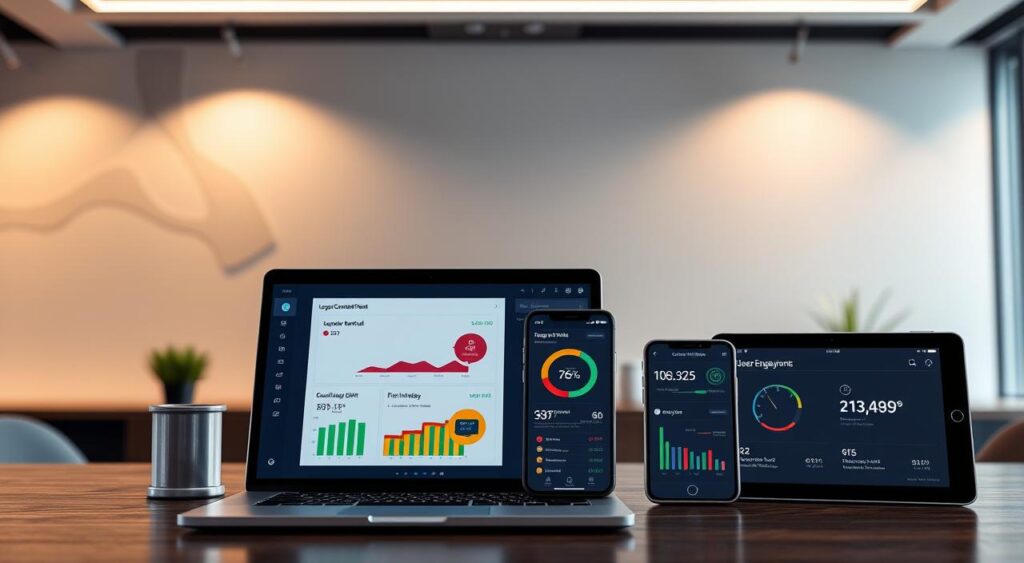As you explore the world of search engine optimization, it’s key to keep up with new trends. These trends will shape the future of SEO in the next few years.
Stay informed about the latest trends to keep your online presence strong. In 2025, expect to see a big rise in semantic search and voice search optimization.
Knowing these trends will help you optimize your online strategy. This way, you’ll stay ahead of your competitors.
The Rise of Semantic Search as a famous SEO Trends
As we explore SEO trends for 2025, it’s clear that semantic search is changing the game. Understanding user intentis key, moving from just matching keywords to grasping the context and meaning of search queries.
Semantic search is reshaping SEO, making it vital to update your strategies. It’s not just about using specific keywords. It’s about making content that really answers what your audience is looking for. This means knowing your audience well and what they search for.
Implementing structured data is a big step in this journey. Schema markup helps search engines understand your content better. This boosts your search ranking and makes search results more useful for users.
To make the most of semantic search, focus on creating top-notch, engaging content. It should meet your audience’s needs and concerns. This means understanding language nuances and how users search for related information.
By adopting semantic search, you’re not just optimizing for search engines. You’re also improving the user experience. This aligns with search engine optimization predictions for 2025, which highlight the need for user-focused content.
As you continue with your SEO plans, remember semantic search is more than technical tweaks. It’s about building a real connection with your audience through valuable and relevant content.
Voice Search Optimization Techniques
Voice assistants are becoming more popular, making it key to adjust your SEO for voice search. Voice searches are longer and more like talking than typing. This means you need a new way to pick keywords.
Long-tail keywords are great for voice search. They’re specific and have lower search numbers. But they’re also less competitive and more focused on what you offer. For example, instead of “best Italian restaurants,” aim for “best Italian restaurants in New York City.”
Using natural language in your content is another smart move. Voice searches sound like real conversations. So, making your content sound like it’s talking can help it rank better. You might use headings that ask questions, like “What are the benefits of voice search optimization?”
To get better at voice search, you need to look at your data. Google Search Console and SEMrush can show you how people find your content with voice. They help you see what questions you’re answering and what devices people use.
Optimizing for featured snippets is also key. Voice assistants often read out these snippets. To get featured snippets, give clear, short answers to common questions. Use structured data to help search engines understand your content better.
By using these voice search tips in your SEO, you can get more seen in voice search results. This keeps you up-to-date with the latest SEO trends and techniques.
Importance of Mobile-First Indexing
Mobile-first indexing is now the standard. It’s key to grasp its impact on your website’s SEO. Search engines prioritize your mobile site when indexing. So, making sure your mobile site works well is critical.
To lead in the evolving SEO landscape, focus on a few key points. First, optimizing page speed is essential. Slow sites can hurt your rankings. Make sure images are small and code is compact to speed up your site.
Also, having a responsive design is vital. It makes your site work on all devices. Google says, “Responsive design lets your site adjust to different screens and devices.”
“The mobile-first indexing means that we’ll be using the mobile version of your content for indexing and ranking…,” as emphasized by Google.
Keeping your site easy to navigate is also important. A simple navigation helps users find what they need fast. This can lead to more engagement and lower bounce rates. As we look to the SEO forecast for 2025, being ready for these changes is essential.
By working on these areas, your site will be ready for today’s and tomorrow’s SEO. This will help drive more traffic and meet your online goals.
The Role of AI in SEO Strategy
Artificial intelligence (AI) is changing how we do search engine optimization. You might know AI tools are key in SEO now.
AI is making a big difference in two main areas: content creation and keyword research. With AI tools, you can make great content faster. They look at lots of data to see what your audience likes, helping you make content they want.
Content Creation with AI: AI tools help make content that grabs attention and ranks well on search engines. They look at trends and data to suggest topics and even write articles. This saves you time and effort.
Keyword Research Enhanced by AI: AI makes keyword research better by looking at huge amounts of data. It finds keywords, trends, and patterns humans might miss. This helps you make your content better, boosting your search rankings.
The future of SEO is closely tied to AI and machine learning. As AI gets better, we’ll see more advanced tools in SEO. Keeping up with these changes is key for your SEO strategy.
Using AI in your SEO plan means you’re not just following trends. You’re setting yourself up for success in the fast-changing SEO world.
EAT: Expertise, Authoritativeness, Trustworthiness
Understanding EAT – Expertise, Authoritativeness, Trustworthiness – is key for any SEO plan in 2025. Google’s EAT criteria help decide if your site is credible. It’s vital to show these qualities to rank high.
To boost your EAT, make high-quality, authoritative content that shows your niche expertise. Create well-researched, engaging content that meets your audience’s needs. Also, get high-quality backlinks from trusted sites to increase your site’s authority.
Trust signals are also important for EAT. Use customer reviews and trust badges on your site to make it more trustworthy. Reviews offer social proof, and trust badges show your site’s security and credibility.
Building Authority
Building authority in your niche is complex. It’s not just about creating great content. It’s also about engaging with your audience and showing your expertise through different channels. This improves your EAT score and makes your site more visible and credible to users and search engines.
As you follow the latest SEO strategies and trends in 2025, remember EAT changes with Google’s algorithms. It’s important to keep up and adjust your plans as needed.
Core Web Vitals and User Experience
Core Web Vitals are now key for ranking well on search engines. They highlight the need for a smooth user experience on your site. For 2025, optimizing these metrics is vital for better rankings and user satisfaction.
Core Web Vitals measure your site’s performance and usability. They focus on loading speed, how interactive it is, and visual stability. A well-performing site in these areas will attract more users and search engines.
Measuring Page Speed and Interactivity
To boost your site’s Core Web Vitals, start by checking its current performance. Use tools like Google PageSpeed Insights and Lighthouse. They analyze metrics like Largest Contentful Paint (LCP), First Input Delay (FID), and Cumulative Layout Shift (CLS).
After spotting areas for improvement, work on making your site faster and more interactive. This could mean optimizing images, using browser caching, and reducing JavaScript times. Such efforts will enhance your site’s user experience and search rankings.

Enhancing Core Web Vitals requires a detailed plan. Compressing images without losing quality is a good start. Also, use browser caching for faster site loading on repeat visits. And, make sure your site’s layout is stable to improve user experience and scores.
By focusing on these SEO techniques and user experience, you’ll boost your site’s visibility. As we move towards SEO forecast 2025, Core Web Vitals will remain essential for success.
Video Content and SEO Integration
Video content is changing how we do SEO, making it more fun and interactive. Search engines are getting better, and using video in your SEO plan is key.
Video is now a big part of SEO. By making your videos search-friendly, you can get more online visibility. Use the right keywords in titles and descriptions, and add transcripts for better indexing.
Optimizing Video Content for SEO means doing several things. Make sure your video titles are clear and include your main keywords. Your video descriptions should also have keywords and a brief summary. Plus, having a video transcript helps search engines understand your video better.
Engagement is key for video content. Videos can keep people on your site longer, which is good for your rankings. Search engines like sites that keep visitors interested.
Here are some tips to boost your video SEO:
– Use eye-catching thumbnails.
– Host your videos on YouTube or Vimeo and embed them on your site.
– Share your videos on social media to get more views.
– Keep your videos fresh to keep your audience coming back.
Looking at SEO updates for the future, video content will be even more important. Optimizing your videos for search engines will help you stay ahead in the fast-changing SEO world.
Local SEO Trends to Watch
Location-based searches are on the rise. As a business owner, knowing the top SEO trends is key. They can make or break your online presence locally.
Google My Business is a big deal now. Claim and optimize your listing to boost local search visibility. Make sure your hours, address, and contact info are current.
Local reviews are also critical. They improve your reputation and search rankings. Ask happy customers to leave reviews on your Google My Business and other sites.
Optimizing for Voice Search
Voice search is growing fast. Make your content speak like people do. Use natural language and long-tail keywords to catch more voice searches.
Creating content for your local audience is another smart move. Write about local events, news, or topics of interest. This will draw in local traffic and boost your online presence.
In short, keeping up with local SEO trends is vital for local businesses. Use Google My Business, encourage reviews, optimize for voice search, and create local content. This will help you attract more customers.
The Impact of Influencer Partnerships
As you explore the world of SEO, remember the role of influencer partnerships. They are a key part of advanced SEO, helping you reach new people and boost your site’s trustworthiness.
Choosing the right influencers is critical. Look for those who match your niche and have active followers. Check their content, audience, and engagement to make sure they fit your brand.

Success in influencer campaigns is measured by engagement and site traffic. Keep an eye on likes, comments, and shares. Also, watch how your site performs to improve your strategy.
The future of SEO will rely on smart influencer partnerships. As search engines evolve, quality content will become even more important. Using influencers can help you stay ahead and attract more visitors.
To benefit from influencer partnerships, aim for lasting relationships. Create engaging content that speaks to their audience and promotes your brand.
The Future of Link Building
Looking ahead to 2025, link building remains key in SEO. But now, it’s all about quality over quantity. You should aim for backlinks from trusted sources, not just many low-quality ones.
To stay on top in SEO, think about content partnerships and broken link building. These methods can get you valuable backlinks. By focusing on quality and relevance, your site’s credibility and rankings will improve.
As SEO keeps changing, being flexible and focused on value is vital. This way, you’ll be ready for 2025’s SEO trends. You’ll achieve lasting success in the fast-paced world of SEO.

